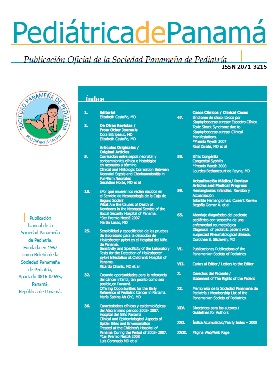1,
1
Show Affiliation
Authors
DOI:
https://doi.org/10.37980/im.journal.rspp.20171666Abstract
Introduction: Enteral nutrition (EN) en the critical ill patient is a controversial topic. This controversy stems from the fact that there is great variability in the way that Intensive Care Units (ICU) administer EN; parameters like when to initiate, what route to use, how to deliver and how better use the algorithms based in the clinical status of the patient are still without a consensus. There are several studies comparing the use of continuous versus intermittent gastric feeding. These studies look at several parameters such as medical complications and the achievement of pre-established nutritional goals. Studies done in adults has not shown significant differences in the incident of complications. Very few studies have been done in children.Methods: Data was collected from two cohorts from the ICU 1 at the Hospital del Nino Dr. José Renán Esquivel: ninety-eight patients who received continuous infusion EN from the year 2016 and ninety patients who received intermittent EN from the year 2012. Both group were on mechanical ventilation.Results: Demographic characterics were similar in both groups, with the exception of the means of age, which was higher in the cases of the year 2016 (7.9 vs 5.4 months, p=0.00) and the mean time to initiate EN. It was lower in the cases 2016 (14.2 vs 19.2 hours, p=0.00). It was shown that continuous feeding increases the probability of achieving 75% of the caloric goal 1.7 times (Cl=1.3-2.2). In the group receiving continuous feeding, patient who achieved 75% and 100% of caloric goals did it faster than in the control group, p=0.00 and 0.02, respectively. We did not find association between the EN and the development of infections, time spent on the mechanical ventilation, length of stay in the ICU and mortality.Conclusions: The use of continuous EN increases the probability of achieving 75% of the caloric goal for the patient and allows to achieve 75% and 100% of the caloric goal faster that bolus nutrition. The development of infections, time spend on the mechanical ventilation, length of stay in the ICU and mortality were similar in both groups.Downloads
Published
2021-06-21
Issue
Section
Artículos originales
License
Copyright (c) 2020 Infomedic InternationalDerechos autoriales y de reproducibilidad. La Revista Pediátrica de Panamá es un ente académico, sin fines de lucro, que forma parte de la Sociedad Panameña de Pediatría. Sus publicaciones son de tipo gratuito, para uso individual y académico. El autor, al publicar en la Revista otorga sus derechos permanente para que su contenido sea editado por la Sociedad y distribuido Infomedic International bajo la Licencia de uso de distribución. Las polítcas de distribución dependerán del tipo de envío seleccionado por el autor.






